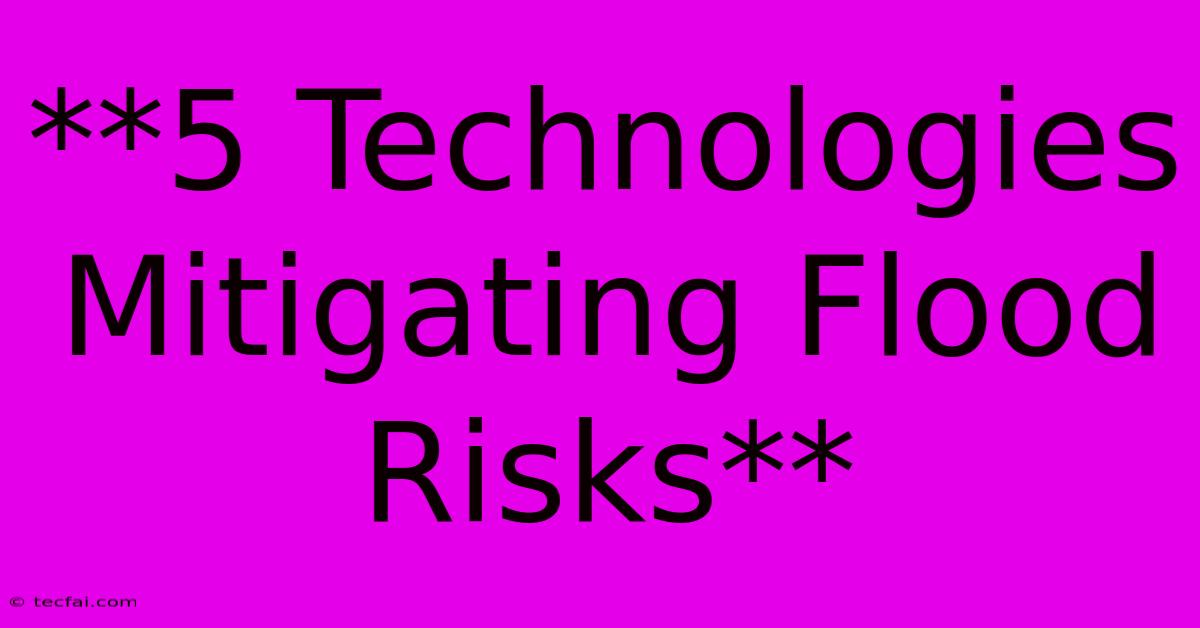**5 Technologies Mitigating Flood Risks**

Discover more detailed and exciting information on our website. Click the link below to start your adventure: Visit Best Website tecfai.com. Don't miss out!
Table of Contents
5 Technologies Mitigating Flood Risks: A Look at the Future of Flood Prevention
Flooding is a devastating natural disaster with far-reaching consequences. As climate change intensifies, the frequency and severity of flooding events are expected to increase, posing a significant threat to lives, property, and infrastructure. Fortunately, technological advancements are offering innovative solutions to mitigate flood risks and build more resilient communities.
Here are five technologies making a difference in the fight against floods:
1. Early Warning Systems:
Real-time monitoring and prediction are crucial for effective flood response. Advanced early warning systems utilize a combination of:
- Sensors: Rain gauges, river level sensors, and weather stations gather data on rainfall, river flow, and other relevant parameters.
- Data Analysis: Sophisticated algorithms process real-time data to predict flood risk and issue timely warnings to authorities and residents.
- Communication Networks: Notifications are delivered through various channels like SMS, social media, and emergency broadcast systems, ensuring swift and widespread dissemination of information.
These systems enable proactive measures like evacuations and infrastructure preparations, significantly reducing the impact of floods.
2. Flood Mapping and Modeling:
Understanding flood vulnerability is essential for effective mitigation strategies. Flood mapping and modeling technologies utilize advanced Geographic Information Systems (GIS) and hydrological models to:
- Identify Flood-Prone Areas: Detailed maps pinpoint areas most susceptible to flooding based on historical data, topography, and rainfall patterns.
- Simulate Flood Scenarios: Models can simulate flood events under different scenarios, providing insights into potential flood depths, extents, and impacts.
- Guide Infrastructure Design: These tools assist in designing flood-resistant structures and infrastructure, minimizing flood damage and ensuring safety.
By accurately assessing flood risk, these technologies empower communities to make informed decisions about infrastructure development and flood preparedness.
3. Sustainable Urban Drainage Systems (SUDS):
Traditional drainage systems often struggle to cope with intense rainfall events. SUDS offer an eco-friendly approach to managing stormwater runoff by:
- Mimicking Natural Drainage: Techniques like rain gardens, permeable pavements, and swales replicate natural drainage processes, slowing down and filtering stormwater.
- Reducing Runoff Volume: SUDS effectively reduce the amount of water flowing into sewer systems, minimizing the risk of overflows and flooding.
- Improving Water Quality: The filtration process removes pollutants from stormwater, contributing to cleaner water bodies and a healthier environment.
By integrating SUDS into urban landscapes, cities can enhance flood resilience and create more sustainable urban environments.
4. Flood-Resistant Materials and Construction Techniques:
Building structures that can withstand flood conditions is critical. Advanced materials and construction techniques are transforming the way we build for flood resilience:
- Flood-Proofing Walls and Foundations: Using waterproof materials, elevated foundations, and flood-resistant coatings can protect buildings from water damage.
- Elevated Structures: Homes and infrastructure can be constructed above flood levels, minimizing the risk of damage and disruption.
- Flexible Building Design: Modular and adaptable structures can be easily adjusted or relocated in response to flood risks.
These innovations ensure that buildings can withstand the impacts of flooding, minimizing property damage and protecting human lives.
5. Artificial Intelligence (AI) and Machine Learning (ML):
AI and ML are revolutionizing flood management by leveraging data to improve prediction and response. These technologies can:
- Enhance Flood Forecasting: AI models can analyze vast amounts of data, including weather patterns, soil conditions, and historical flood events, to provide more accurate and timely flood forecasts.
- Optimize Flood Response: ML algorithms can identify optimal evacuation routes, resource allocation strategies, and flood damage assessment methods.
- Improve Flood Risk Management: AI can be used to develop personalized flood risk assessments for individuals and businesses, empowering them to take proactive measures to mitigate flood risks.
By harnessing the power of AI and ML, we can build smarter and more resilient flood management systems.
Conclusion:
The threat of flooding is real, but technological innovation is offering powerful tools to mitigate risks and protect communities. Early warning systems, flood mapping, sustainable drainage, flood-resistant construction, and AI are transforming our approach to flood management, enabling us to build a future where we are better prepared to face the challenges of a changing climate. By embracing these technologies, we can create a safer and more resilient future for all.

Thank you for visiting our website wich cover about **5 Technologies Mitigating Flood Risks**. We hope the information provided has been useful to you. Feel free to contact us if you have any questions or need further assistance. See you next time and dont miss to bookmark.
Featured Posts
-
Isang Michelin Star Lang Para Sa Ice Cream Shop
Nov 06, 2024
-
Jury Sworn In Mc Gregor Civil Assault Trial
Nov 06, 2024
-
Sino Ang Presidential Candidate Na Si Chase Oliver
Nov 06, 2024
-
Valencia Floods La Liga Continues
Nov 06, 2024
-
Jill Steins Election Strategy Explained
Nov 06, 2024
